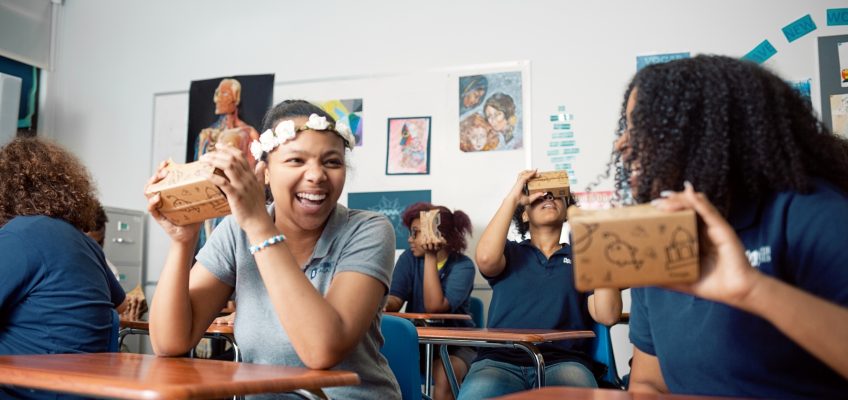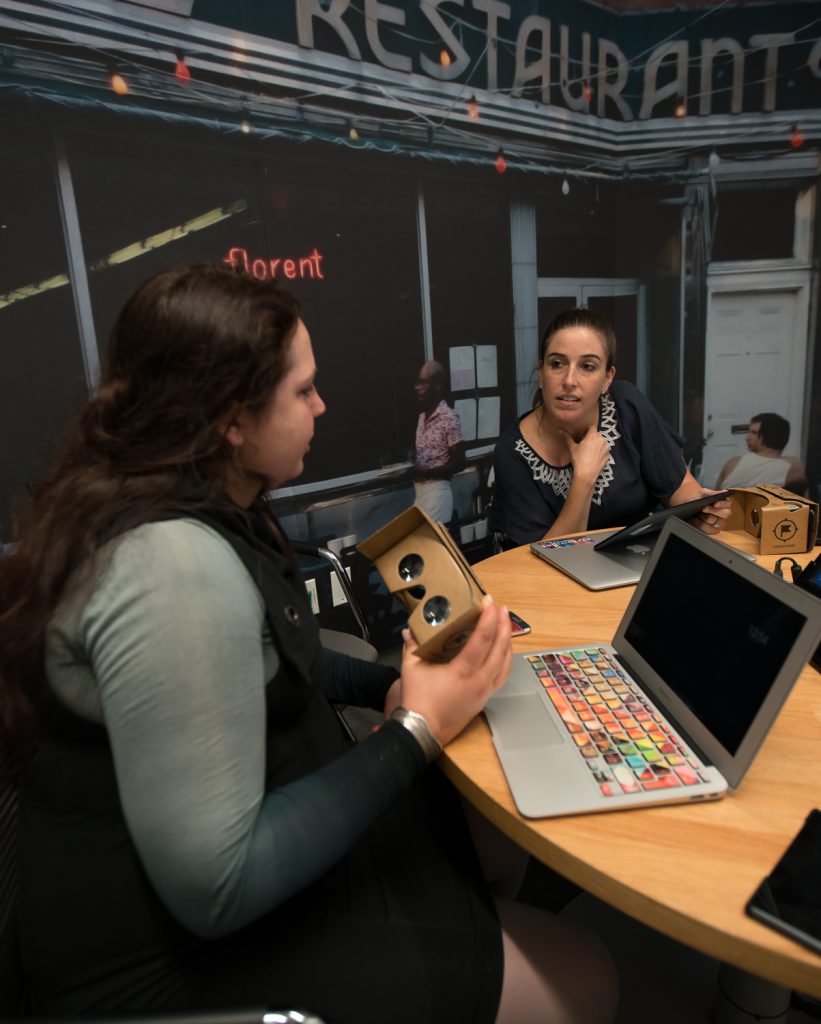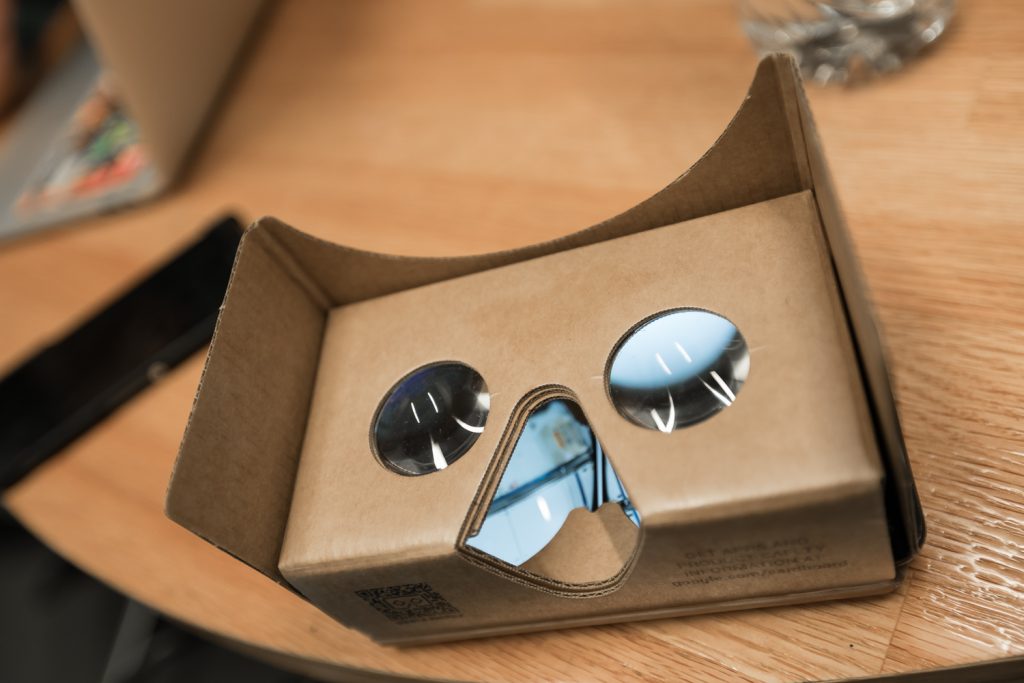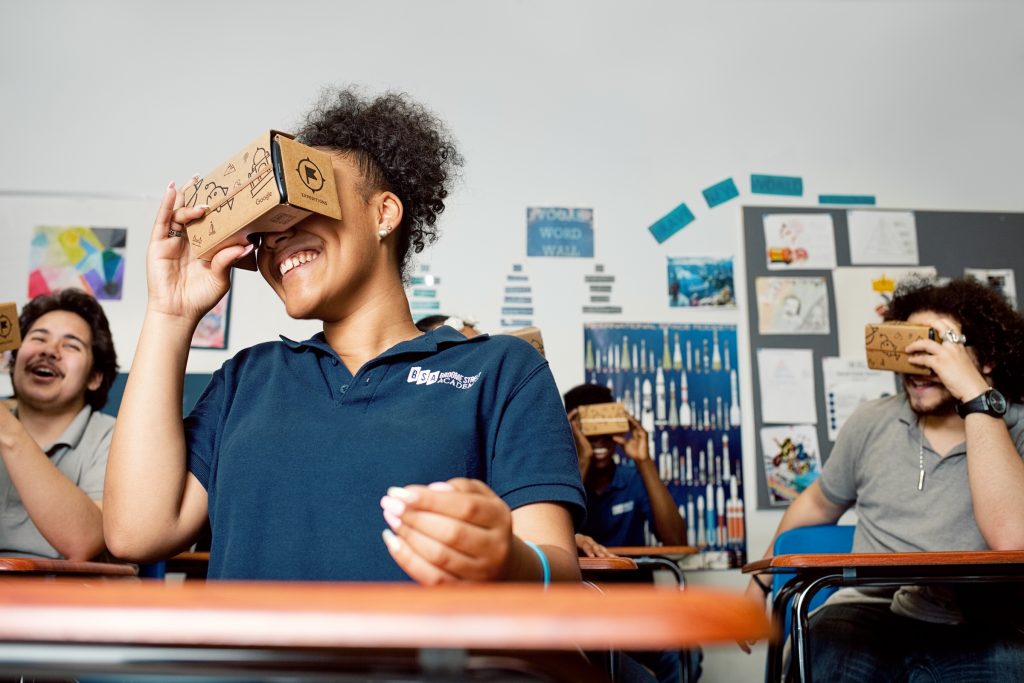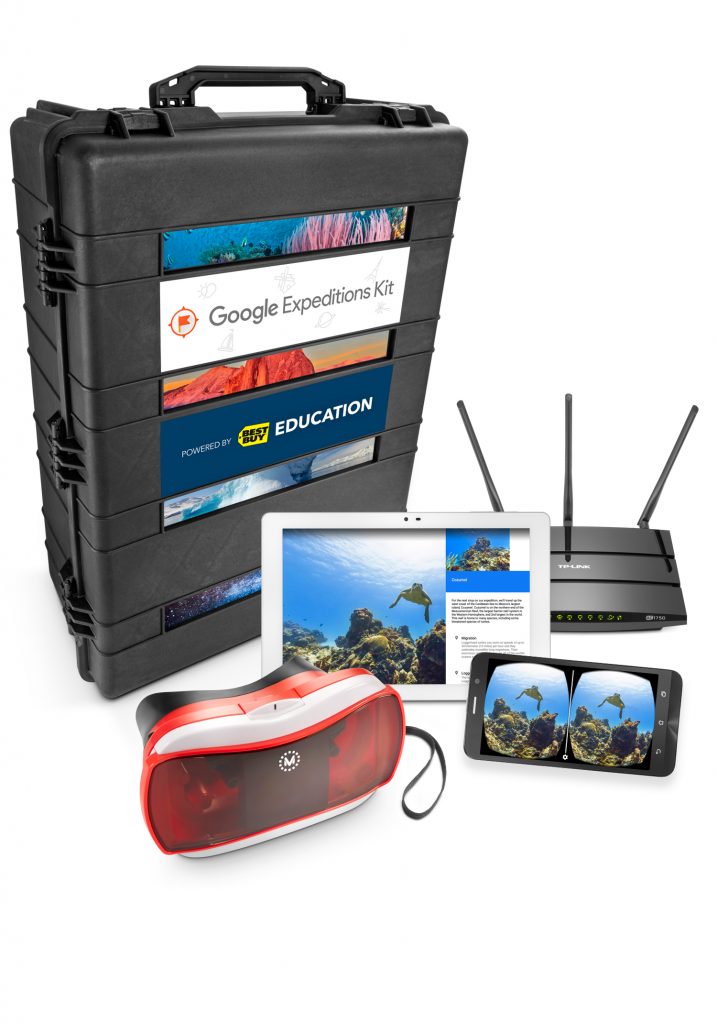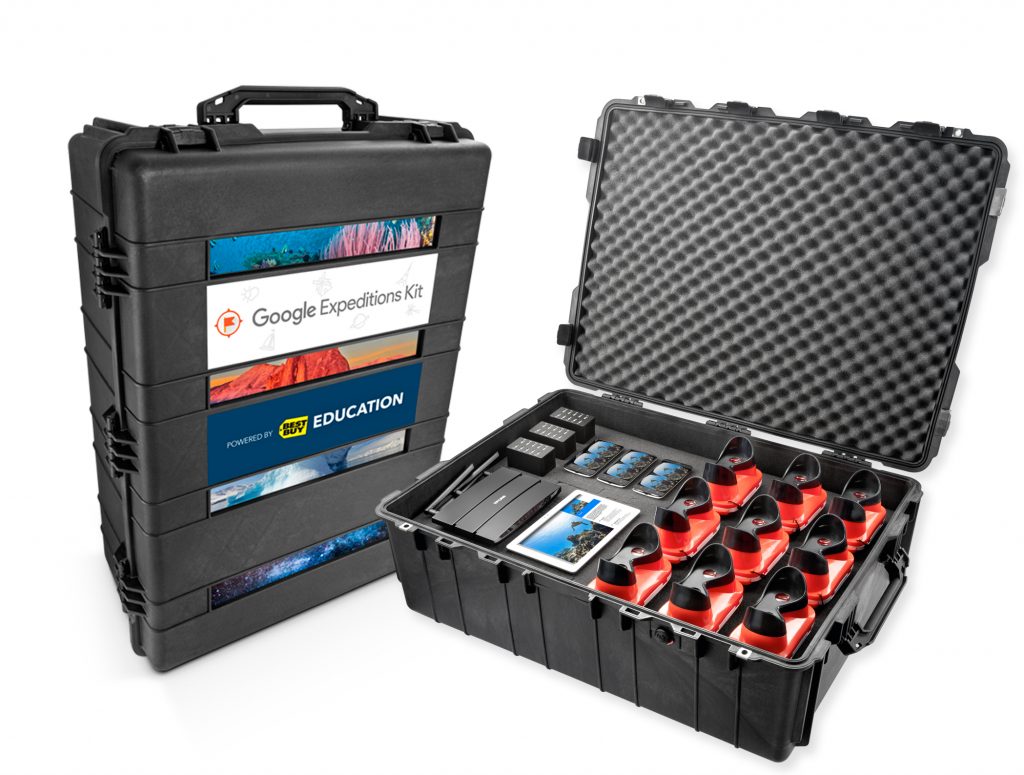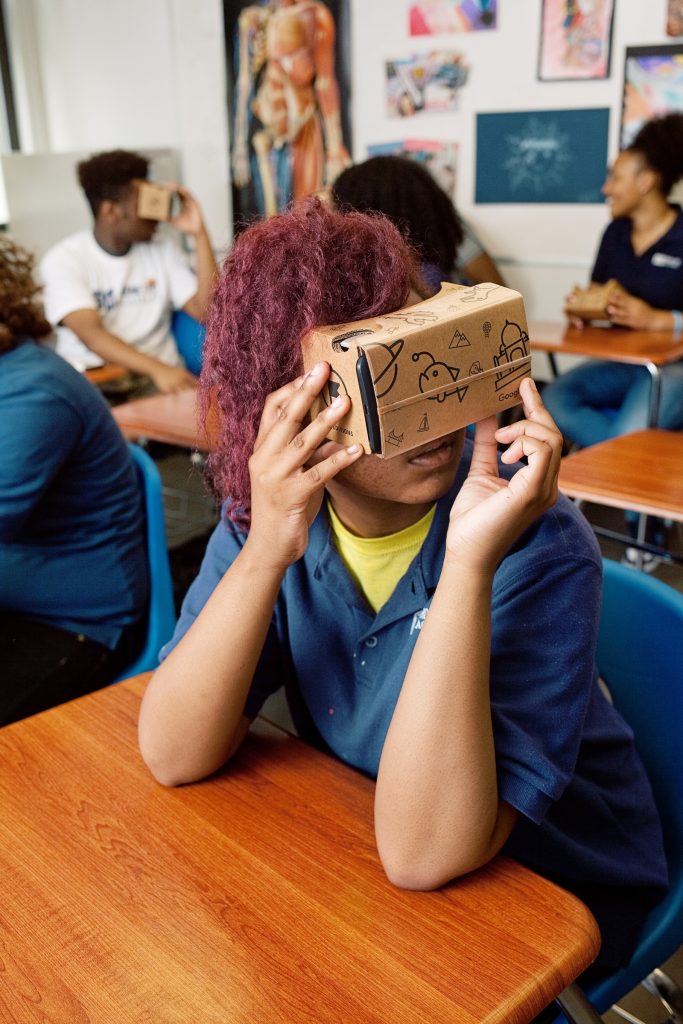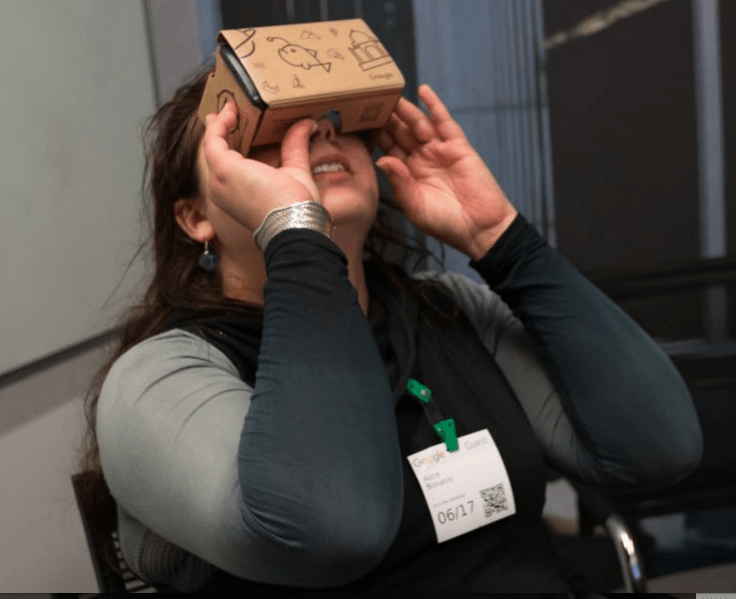At ISTE 2016, Google for Education announces global rollout of VR Expeditions and key partnerships with TES Global, Pearson and hardware providers
Whenever I write about using Virtual Reality in the classroom I get responses from teachers expressing concern that virtual experiences should not be seen as replacement for real ones. “Why not just go outside?” some ask. Those are valid concerns and reflect a fear that this relatively unknown technology will prove isolating for students with an already worrying amount of screen time in their lives.
And that is something I put to Google’s Jennifer Holland and Ben Schrom when I visited their New York office recently to talk about the future of Google Expeditions, their educational VR offering:
We took steps from the get-go to make Expeditions really social Click To Tweet“We took steps from the get-go to make Expeditions really social,” Explains Schrom, Product Manager for Google Expeditions. “It’s not a canned, solitary experience. It is teacher-led so every time you do an Expedition, it is different.”
VR in education is not just about bringing fantastic or inaccessible experiences to students, but also to connect them with the world around them in different ways. Think about the way that we often ignore the places of interest in our local town until we have a visitor to show around. It gives us an excuse to look around with fresh eyes and (re)discover fantastic things that were right on our doorstep all along. Holland, who is Program Manager for Google Apps for Education, believes that VR can similarly be catalyst for students to see the world from another perspective:
“We initially thought that Expeditions would be about taking students to all these majestic places, letting them explore Mount Everest, the Taj Mahal, and even Mars. But we soon found out that it was about much more than that. We can bring historical moments to life, or we can give insight into what someone’s job is like to those who don’t have access to internship or mentors. We recently piloted some Career Expeditions where you can follow a Palaeontology Professor from the Natural History Museum, or an Pilot for American Airlines and see what they like (and don’t like) about their work.”
In fact, ordinary experiences that some of us take for granted can actually be out of reach for many, and VR could help bridge that gap: One example of this is the Reach Higher initiative championed by First Lady Michelle Obama, which aims to encourage students from diverse backgrounds to apply and go to college. She saw Google Expeditions as a great tool for helping students in that process, allowing them to visit various college campuses through VR. This started the process of allowing young people who had no previous experience of college to visualise themselves in that environment, encouraging them to take that first step towards applying.
Since their beta launch less than a year ago, the Google Expeditions Pioneer Program has taken over a million kids from 11 countries on Virtual Reality field trips, and at ISTE 2016 Google announced that they’re rolling out Expeditions to everyone. Teachers are now able to download the Expeditions app – currently on Android but with an iOS version promised to follow soon – which works on a range of devices and provides access to over 200 Expeditions. Google also says it is working with established educational content providers such as Pearson and Houghton Mifflin Harcourt to expand that offering, and announced a partnership with TES Global, a service already used by over 8 million teachers to discover and share lesson plans and digital educational content. This integration means teachers will be able to easily view and download content from the Google portal directly from within TES.
VR, as it turns out, is proving a very useful tool for teachers to retain attention Click To TweetHolland says that they took several key learnings from the pilot, including that they should not label expeditions by subject or grade:
“If you assign a level to an expedition, you find that people only use it for that level, but as soon as we removed those tags, we see those same expeditions being used in all sorts of creative ways,” she explains
Instead, they focused on providing tools to allow teachers to personalise each Expedition, supplying background information so that they don’t have to spend a lot of time doing basic research, and mechanisms such as a pause button which gives them full control of the lesson flow:
We wanted to ensure Expeditions could be run with little or no Internet connectivity Click To Tweet“We found that as soon as teachers press the pause button, students automatically put the goggles down, they don’t have to be told. It works really smoothly as part of an interactive lesson. Teachers actually joked that they wished we could implement that button on all their devices.” VR, as it turns out, is proving a very useful tool for teachers to retain attention, as it can be very effective in removing distractions and allows students to fully focus on the lesson content.
Another concern was how to make Expeditions universally accessible by removing as many technological barriers as possible. This included making it work on devices teachers and students already had, such as tablets, but also ensuring that Expeditions could run even with little or no Internet connectivity:
“We did that by enabling the teacher’s tablet to be used in such a way as to operate like a local server, connected to all of the viewing devices; so as long as the materials are cached in the tablet all the students can go on the expedition. This means we can take it anywhere, from a rural area in Ghana to the Amazon rainforest,” says Schrom
As well as empowering teachers, Google found that the greatest engagement around Expeditions happened when students themselves were empowered to take charge of their learning, and share that knowledge with their classmates.
“One of the first things we saw with expeditions was teachers assigning students to become expert guides on particular Expeditions. When a student is empowered to become an expert, they become excited, and learning happens organically, so much so that they don’t even realise they’re learning!” says Holland, clearly enthused at the feedback they received.
She goes on to give an example of that sort of empowerment taking place not far from where we’re sitting: One New York school taking place in the Expeditions beta program had taken students on a virtual trip to Ellis Island. Teachers were curious to see what those students’ reaction would be when they actually visited the island. Would they be bored?
“One of the guides from Ellis Island told us that they’d never seen students so excited, where they saw themselves as the experts. They were demanding to see the dormitory and all the places they had been to in the virtual Expedition, it became this scavenger hunt. And the nice thing is that some of the rooms they had weren’t actually open, they were behind glass, but in expeditions they had been able to go inside, so they were turning to the guide and explaining all those things to him.”
Teachers reported that the difference between student groups that had done the Expedition beforehand and those that hadn’t was “like night and day”. Having that baseline of information and a connection to it made their real world experience of the island, and their learning, a lot more meaningful.
Having that baseline information made the real-world experience much more meaningful to students Click To TweetSamson Meyer, a 6th Grade Math Teacher at Muller Road Middle School in Columbia, SC agrees that giving students a real-world application for knowledge is the best way to drive engagement: “Sometimes the best way to help students is using the voice of another student. We teach each other different ways of learning.”
The best way to help students is using the voice of another student. Click To Tweet“I have this vision of that big computer/TV/VCR trolley that was wheeled into the classroom in the old days, and have a feeling that in future it will be the virtual reality kit that is wheeled in to transport kids directly to Machu Picchu, or to experience a chemical reaction on an atomic level,” says Schrom, echoing a vision expressed by other key players in the VR space such as Linden Lab’s Ebbe Altberg, Nearpod and EvoBooks.
“So we’ve put together this kit that has everything a teacher needs, all the viewers, all the devices, a tablet for the teacher and a router. Our goal is to start building a platform for all sorts of VR applications and use this as a way to convince schools that this is a valuable piece of hardware for them to have in their classes.”
While Expeditions can be used with many of the devices that schools and students already have, such as smartphones, Google Cardboard or tablets, Best Buy Education will also be making those ready-made Expeditions kits available for schools to purchase. Google will also be publishing specifications to allow other hardware partners to create their own kits.
The next step would logically be to also empower users to create their own content, but that is something that is still prohibitive due to high costs of 360 camera gear. The Odyssey Rig with Google’s Jump camera and GoPro is not something that most individuals or schools can readily afford at this point, but that is likely to quickly change as the VR arms race continues to drive up quality and push down prices.
The possibilities of all the things you can do with VR are mind boggling Click To Tweet“This is very early days, but we feel that this is the beginning of a super-bright future and the possibilities of all the other things you can do with VR are mind boggling,” says Schrom.
Google is already starting to pilot Expeditions beyond the classroom, in Senior Citizen homes and Children’s hospitals, for example.
We have lots of requests from senior citizens to go to Verona and see the setting of Romeo and Juliet Click To Tweet“We have lots of requests from senior citizens to go to Verona and see the setting of Romeo and Juliet, and children in hospital asking to go underwater. They hold their breath, put on the goggles and start exploring the Great Barrier Reef, and for that moment, they forget about their illness.”
The main reason why many educators are getting so excited about VR is because it’s seen as a way to scale up experiential learning, and this is seen as particularly important in giving students the skills needed in the digital age. At Google IO earlier this year, Schrom outlined the basic problem with traditional learning, which is that it is still fundamentally based on retrieving, retaining and recalling facts. But knowing facts, he argued, does not actually equate to learning. As an example he shared the following maths problem:
“There are 26 goats and 10 sheep on a boat. How old is the captain of the boat?”
It might (or might not) surprise you that in a study conducted amongst 5th graders in the 1990s, over two thirds of them produced a numerical answer to that question.
In the “Information Saturation” age where access to knowledge is becoming increasingly pervasive, it’s the ability to process that knowledge intelligently that we need to teach the next generation. Not to get overly political here, but we did recently experience a rather dramatic example of this in last week’s UK referendum, where many people who voted for the country to leave the European union went on to express regret at their decision on the grounds that they had not understood the implications. Google search term analytics in fact showed a sharp spike in queries such as “what is the EU?” peaking around midnight after the polls closed, just as the option to leave started to materialize into a real possibility.
It’s the ability to process that knowledge intelligently that we need to teach the next generation Click To TweetI will leave it to readers to draw their own conclusions as to whether this presents a problem, and whether education technology can perhaps be part of the solution.
To find out how to leverage VR/AR/MR in your enterprise, Tech Trends offers bespoke Virtual Reality Consultancy support
Alice Bonasio is a VR Consultant and Tech Trends’ Editor in Chief. She also regularly writes for Fast Company, Ars Technica, Quartz, Wired and others. Connect with her on LinkedIn and follow @alicebonasio and @techtrends_tech on Twitter.

